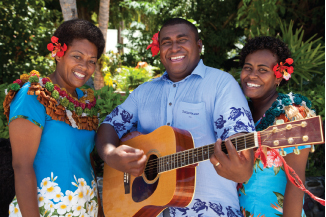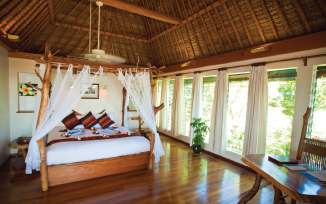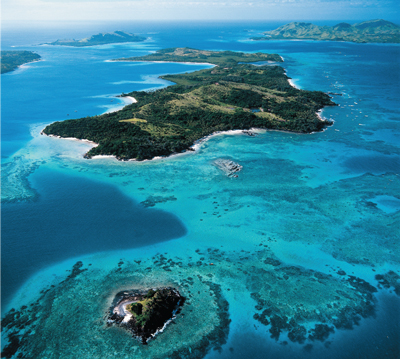From the moment I stepped off the 747 in Nadi (direct from Los Angeles on Air Pacific) and onto a Turtle Airways De Havilland Beaver floatplane for the 30-minute hop to Turtle Island, my familiar mode of transportation — and sense of rhythm — changed. As the drone of the engine drowned out the electronic hum of daily life and warm, salty air funneled onto my face through an open cockpit window, I said good-bye cars, trains, buses and traffic and hello seaplanes, skiffs and flip-flops.
Clusters of islands 1,000 transformative feet below interrupted the seamlessness of the sea, and around them the turquoise shallows of their coral reefs shimmered in contrast to the azure of the deeper water. As the plane landed and glided to shore, two fit (and very fine-looking) Fijian men clad in ceremonial grass skirts waded through the warm surf and offered to carry the ladies to the beach.
After just one look at Turtle Island’s white-sand coastline and aqua-blue waters, it’s easy to understand why Richard Evanson, an American businessman who made a fortune in the cable television industry, bought Turtle Island (then named Nanuya Levu) in 1970, intent on moving there. At the time, however, the 500-acre island was uninhabitable and overrun with wild goats. Evanson began a restoration by planting more than 500,000 trees and getting rid of the goats (local villagers captured them and took them to neighboring islands for food) but never planned to build the world-class resort Turtle Island is today. That vision began in 1980 when Columbia Pictures told Evanson it wanted to use the island to shoot a remake of Blue Lagoon. (The original, starring Jean Simmons, was filmed on the island in 1948.)
Evanson agreed to the project, and Columbia built three traditional Fijian thatched homes, called bures, for the producer, the director, and actor Brooke Shields and her mom. When the filming was finished, Evanson converted the bures into a resort and rechristened the island with its current name. It took him another decade to finish all the bures and create the all-inclusive resort that Travel+Leisure called “one of the top 10 best Pacific hotels in 2000.” Today’s bures are large (1,200 square feet) — triple the size of my old Gramercy Park apartment in New York — and elegantly appointed with cabinetry and countertops crafted in the island workshop from mahogany trees Evanston planted decades ago.
 Turtle Island, with a maximum capacity of 14 couples, is designed for intimacy and romance and accepts children only a few weeks a year. During our stay, we met one couple who had a seaside wedding on the island, two sets of honeymooners, three couples celebrating an engagement or recent marriage and at least four couples marking anniversaries that spanned from two to 32 years. Each received a customized cake and personalized serenades from the staff.
Turtle Island, with a maximum capacity of 14 couples, is designed for intimacy and romance and accepts children only a few weeks a year. During our stay, we met one couple who had a seaside wedding on the island, two sets of honeymooners, three couples celebrating an engagement or recent marriage and at least four couples marking anniversaries that spanned from two to 32 years. Each received a customized cake and personalized serenades from the staff.
One of these couples, Sam and Kim from Los Angeles, honeymooned on Turtle Island 25 years ago and had returned for their silver anniversary. They leapt off the seaplane clad in the same Turtle Island T-shirts they bought a quarter-century earlier. On the day of their anniversary, Shakira, a spirited staffer, jumped out of a hand-crafted papier-mâché cake with sparklers and champagne.
If love, romance and plenty of cake are Turtle Island’s signature characteristics, then its soul is the sea, a healing tonic of 78-degree water that incubates the surrounding coral reefs and nourishes teeming tropical fish habitats, an accessible paradise for snorkelers and scuba divers. Turtle Island is part of the Yasawa chain in the Fijian archipelago, home to one of world’s most extensive coral reef systems that, thankfully, has escaped the catastrophic bleaching caused by global warming that has devastated so many other coral reefs. Visitors are rewarded with a spectacular rainbow of marine color, from the fire red of the coral to the azure blue of the starfish.
Turtle Island’s focus on romance extends to those who have a love affair with the sea. Available dalliances and underwater trysts included hour-long snorkel trips led by Dara, who knows the reefs intimately, and zippy skiff jaunts to a neighboring island for a daily complimentary dive with PADI-certified West Side Water Sports on its cool custom dive boats. Divemaster Mo (try saying that out loud; it’s fun) is a patient and kind escort into the submarine world.
The Fijian staff at Turtle Island is lighthearted and playful, quick to grin or shout a warm bula bula (hello). It seems as if everyone plays an instrument. Music and song are heard throughout the day, providing an enjoyable soundtrack that punctuates special celebrations like anniversaries or serves as a soothing companion to the already soporific ceremony of the nightly Kava Bowl — an event that takes place after dinner.
Each evening staff and guests congregate around the ceremonial Tanoa Kava Bowl, hand-carved on the island and decorated with local seashells. As we gather in a ragged circle under the warm evening breeze, the kava is brewed, stories of the day told and laughs shared. Kava, I must say, is a terrible-tasting concoction — muddy, peppery and possessing the texture of grainy wood — but produces a miraculous effect. As it numbs the tip of your tongue, you can feel your body begin to relax. Whatever pain there was in the tasting was well worth it — I slept soundly each evening.
 For anyone not deep-sea fishing, diving or sleeping late, morning begins with breakfast around the community table where Arthur Naisali, the resort’s activities director and the son of Evanson’s first employee, presents the turtle-shaped Bula Board, which outlines the plan for the day. It is a festive time of singing, practicing Fijian words, receiving the all-important private beach assignments for the day and learning about the day’s meal plan.
For anyone not deep-sea fishing, diving or sleeping late, morning begins with breakfast around the community table where Arthur Naisali, the resort’s activities director and the son of Evanson’s first employee, presents the turtle-shaped Bula Board, which outlines the plan for the day. It is a festive time of singing, practicing Fijian words, receiving the all-important private beach assignments for the day and learning about the day’s meal plan.
Nearly all of Turtle Island’s food is locally produced, much of it coming from the property’s four acres of organic farmland. Typically, only items like beef, cheese and wine are flown in. In addition to the communal breakfasts and dinners, guests receive picnic lunches presented at their personal beaches. Specialty chocolates and other sweet treats are baked on premises; I am now addicted to chocolate toffee coconut crunch.
Of all the staff, the most personal relationship you develop is with your bure mama, a cross between a personal concierge and your grandmother. Our bure mama, Mama Nani, was a daily blessing. She cared attentively to attend to our interests and, of course, was always ready with a song or an art project.
On the day we left, Arthur gathered the staff for song; Mama Nani gave us a scrapbook she put together and a handmade lei. Once we were aboard the seaplane, our pilot indulged us with one last pass over the island, flying low so that as he dipped his wings in a good-bye wave we saw clearly the smiling faces of our new friends and Fijian family, still singing on the dock below.


